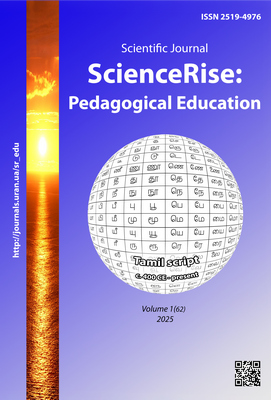Міжкультурна комунікація та культурний стрес студентів-іноземців
DOI:
https://doi.org/10.15587/2519-4984.2025.326517Ключові слова:
мовленнєвий етикет, толерантність, професійна діяльність, культурний стрес, комунікація, міжкультурна комунікаціяАнотація
В даній роботі проводиться аналіз поняття міжкультурна комунікація, комунікація, культурний стрес, мовленнєвий етикет.
Розглянуто проблему як сформувати навички особистості за допомогою яких проходить розвиток міжкультурної комунікації, яка є засобом розуміння особливостей різних культур, котрі є умовою здійснення ефективного діалогу людей у сучасному світі. Доводиться велика роль мовленнєвого етикету у процесі міжкультурного спілкування. Розглядається характеристика міжкультурних непорозумінь у процесі комунікації.
Успішна акультурація вважається важливим завданням викладання вищої математики та фізики. Отже, з однієї сторони, модель культурного стресу добре відчуває процеси та міжкультурні зустрічі. З іншої сторони, в цьому погляді криється схована спокуса провадити несправедливим шляхом роздвоєні культурні відмінності, які стосуються змішаності багатомовного суспільства та його транскультурності. Різні культури мають свої традиції та норми спілкування. Незнання цього питання викликає багато непорозуміння, у зв’язку з чим може бути незбігання культур, виникнути та розвинутися стан, який вважається культурним стресом. Тому, дуже важливо знати норми і традиції спілкування представників народу, які є учасниками мовного діалогу, що належать до різних національних культур. Потрібно спокійно, ввічливо, з повагою та розумінням сприймати один одного, тобто позитивно сприяти розвитку діалогу та міжкультурній комунікації. Що, в свою чергу, сприяє формуванню міжкультурної комунікативної поведінки. Освіта сьогодні набула істотних змін від її призначення до способу викладання. Все це дуже покращило навчальний процес. Це є важливим, адже сучасна освіта належить до вищих цінностей людей та розвитку суспільства, а чим глибший та вищий освітній рівень людини, тим більші та ширші її можливості для створення кращого та цікавого життя. Міжкультурна комунікація – є однією з форм контакту спілкування та комунікації. У міжкультурній комунікації важливо бути готовим до ведення діалогу та спілкування з представниками інших країн. Мати бажання та пристосовуватися до нових умов і виникнення різних несподіваних ситуацій
Посилання
- William, B. (2003). Cross-Cultural and Intercultural Communication. Gudykunst Publisher: SAGE Publications, Inc., 312. Available at: https://books.google.com.ua/books?id=-5sjpr1ypmcC&printsec=frontcover&redir_esc=y#v=onepage&q&f=false
- Manakin, V. M. (2012). Mova i mizhkulturna komunikatsiia. Kyiv: TsUL, 288.
- Voitik, T. H., Kopieikina, T. H. (2024). Osoblyvosti roboty z hrupamy studentiv-inozemtsiv. Mizhkulturna komunikatsiia v konteksti hlobalizatsiinoho dialohu: stratehii rozvytku. Odesa, 171–174. Available at:https://onmu.org.ua/images/university/news/III_Conf_Inter_Cult_2024_art.pdf
- Maltseva, K. S. (2002). Mizhkulturni neporozuminnia i problema mizhkulturnoho perekladu. [Extended abstract of PhD thesis; In-t filos. im. H. S. Skovorody NAN Ukrainy].
- Halytska, M. M. (2014). Intercultural communication and its significance for professional activities of future specialists. Osvitolohichnyi dyskurs, 2 (6), 23–30. Available at: https://core.ac.uk/download/pdf/33686839.pdf
- Piller, I. (2010). Intercultural communication: A Critical Introduction. Edinburgh University Press, 178.
- Tolok, D., Deinichenko, T. (2022). Innovatsiini formy i metody v navchanni matematyky. Kharkivskyi natsionalnyi pedahohichnyi universytet imeni H. S. Skovorody Kharkiv. nats. ped. un-t im. H. S. Skovorody. Kharkiv, 219–221. Available at: https://dspace.hnpu.edu.ua/handle/123456789/9126
- Voitik, T. H., Puchkov, B. V., Kopieikina, T. H. (2022). Rozvytok mizhkulturnoi komunikatsii studentiv-inozemtsiv na laboratornykh ta praktychnykh zaniattiakh z fizyky ta matematyky. Mizhkulturna komunikatsiia v konteksti hlobalizatsiinoho dialohu: stratehii rozvytku. Chastyna II. Odesa, 212–216. https://doi.org/10.36059/978-966-397-280-0-64
- Chumanska, S. (2015) Vykorystannia innovatsiinykh tekhnolohii na urokakh matematyky yak umova sotsializatsii uchniv. Tavriiskyi visnyk osvity, 1 (149), 178–183. Available at: http://nbuv.gov.ua/UJRN/Tvo_2015_1_31
- Tkach, K., Homeniuk, H. (2022) Interaktyvni metody navchannia na urokakh matematyky z vykorystanniam IKT. Suchasni tsyfrovi tekhnolohii ta innovatsiini metodyky navchannia: dosvid, tendentsii, perspektyvy, 9, 184–187. Available at: http://dspace.tnpu.edu.ua/bitstream/123456789/27599/3/Tkach_Gomenuk.pdf
- Zelikovska, O. O., Cherednichenko, H. A. (2012). Formuvannia mizhkulturnoi kompetentsii studentiv ekonomichnykh spetsialnostei u protsesi fakhovoi pidhotovky. Kyiv: Kondor-Vydavnytstvo, 321. Available at: https://dspace.nuft.edu.ua/handle/123456789/8788
- Mustafa, Y. (2021). A Review of Culture Shock: Attitudes, Effects and the Experience of International Students. Journal of Intercultural Communication, 21 (3), 4–25. https://doi.org/10.36923/jicc.v21i3.18
##submission.downloads##
Опубліковано
Як цитувати
Номер
Розділ
Ліцензія
Авторське право (c) 2025 Tetiana Voііtik, Tetiana Kopeykina

Ця робота ліцензується відповідно до Creative Commons Attribution 4.0 International License.
Наше видання використовує положення про авторські права Creative Commons CC BY для журналів відкритого доступу.
Автори, які публікуються у цьому журналі, погоджуються з наступними умовами:
1. Автори залишають за собою право на авторство своєї роботи та передають журналу право першої публікації цієї роботи на умовах ліцензії Creative Commons CC BY, котра дозволяє іншим особам вільно розповсюджувати опубліковану роботу з обов'язковим посиланням на авторів оригінальної роботи та першу публікацію роботи у цьому журналі.
2. Автори мають право укладати самостійні додаткові угоди щодо неексклюзивного розповсюдження роботи у тому вигляді, в якому вона була опублікована цим журналом (наприклад, розміщувати роботу в електронному сховищі установи або публікувати у складі монографії), за умови збереження посилання на першу публікацію роботи у цьому журналі.









